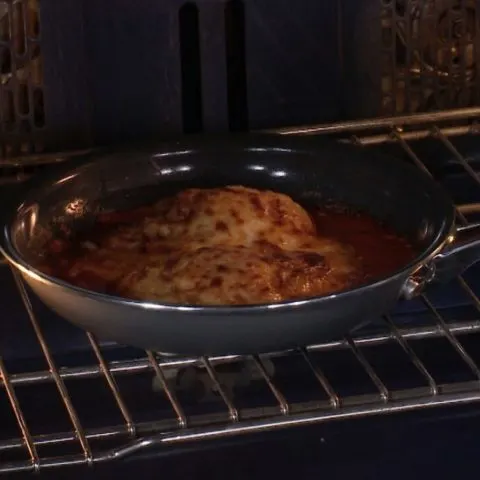Pans might look resilient and indestructible but not every pan is perfect for all cooking plans you might have in mind.
One very delicate scenario is the oven. Since temperatures rise and every part of the pan will be heated, using the wrong type of pan could be catastrophic.
For instance, a pan with the wrong handles will melt or deform in an oven, while some with glass lids might crack as the temperatures rise in the oven.
How to Identify an Oven Safe Pan
Most manufacturers design their pans to place them on any burner. This is because the handles, inner coating, and lid won’t contact direct heat. Here are some tell-tale signs that your pans are oven safe.
It’s Made of the Same Material
Since the oven will heat your pan homogeneously, the pan has to expand and contract evenly; otherwise, it will warp or even crack.
This isn’t a problem if your pan is made of the same material. Hybrid pans with steel or copper Botton and aluminum sides won’t fare well in such a setting.
Confirm that your pan is made of the same material before considering it in your oven.
It’s Marketed as a Baking Dish
An excellent way to be sure your pan will fare well in the microwave is whether the manufacturer markets it as a baking dish or not.
It can endure temperatures in a regular household oven if it’s called a baking dish. Please pay attention to its construction. You will notice it’s made of the same material and has no insulated handles whatsoever.
It has No Wood, Plastic, or Composite Handles
If your pan has no scald handles designed to insulate you from the heat of the pan when handling, then it can’t survive in an oven.
In most cases, these handles will endure conducted heat from a hot pan but will not endure the heightened temperatures they will endure in the oven.
- Plastic inserts will melt.
- Wood could smoke and start burning
- Composite handles will crack and be ruined
A common workaround if you have to use the pan in the oven is removing the handle. Most handles are screwed on and detached from the pan at will.
There’s an Oven Safe Symbol
Different manufacturers use different oven-safe symbols on their pans. The sign means the pan can go into an oven without getting damaged.
However, it would help if you still went through your user manual or specifications to identify how much heat the pan can take.
Are Cast Iron Pans Oven Safe?
Virtually all cast iron pans are oven safe – as long as they don’t have a wood, plastic, or composite handle.
Iron has a very high melting point making cast iron pans perfect for stove to oven use. They do not have the 500 degrees Fahrenheit limit you might expect in other coated pans and can easily go onto wood-fired ovens without any damage.
You could also use bare aluminum or stainless steel pans and pots in the oven as long as they do not have a different material handle.
Are Non-Stick Pans Oven Safe?
Nonstick ovens can be oven safe as long as they meet any of the requirements we described above. However, the standard nonstick treatment (Teflon) is only stable at temperatures under 500 degrees Fahrenheit.
Most domestic ovens don’t get this hot, meaning you should get away with it unless you use a wood-fired oven or a commercial high-temperature oven.
Are Tefal Pans Oven Safe?
Tefal is a cookware manufacturer. There is no blanket answer on whether Tefal pans are oven-safe or not.
The company has a lineup of regular cooking pans and dedicated oven-safe pans. Running your pan through the reasoning criteria, we started with will help you determine if you can stick your pan into an oven or not.
Are Cuisinart Pans Oven Safe?
Cuisinart is also a cookware manufacturer. They have a catalog of oven-safe and non-oven-safe pans too. Take the time to investigate your pan, and don’t stick it straight into an oven because Cuisinart makes it.
Here is a look at some of their pan oven safe ratings
| Oven Safe Pan Type | Oven Safe Rating (Degrees Fahrenheit) |
| All Metal | 350 |
| Stainless Steel | 500 |
| Hard-Anodized Aluminum | 500 |
| Stainless Steel Lids | 500 |
| Glass Lids | 350 |
What Happens if You Use a Non-Oven Safe Pan in an Oven?
Sticking a non-oven safe pan into an oven will often leave you with a ruined pan. Any part of the pan that can’t endure the high temperatures will melt, crack or warp.
The sticky mess will be a hazard when you try to remove the pan from the oven. This, coupled with the fact that your pan will be ruined, makes you understand how much oven heat a pan can take.
Check this too: How Do You Clean a Scorched Pan?
Bottom Line
From experience, I found that I never have to worry about a pan being oven safe if I have baking pans and cookware made of pure stainless steel, copper, or cast iron with no additives.
The stainless steel sheet pans are plentiful in the oven and cheap. They can endure most oven temperatures without melting or warping.
Cast iron is the ultimate if your oven occasionally heats to very high temperatures. However, you shouldn’t worry about temperature limits since very few recipes will ever want you to crank it up over 500 degrees Fahrenheit.

